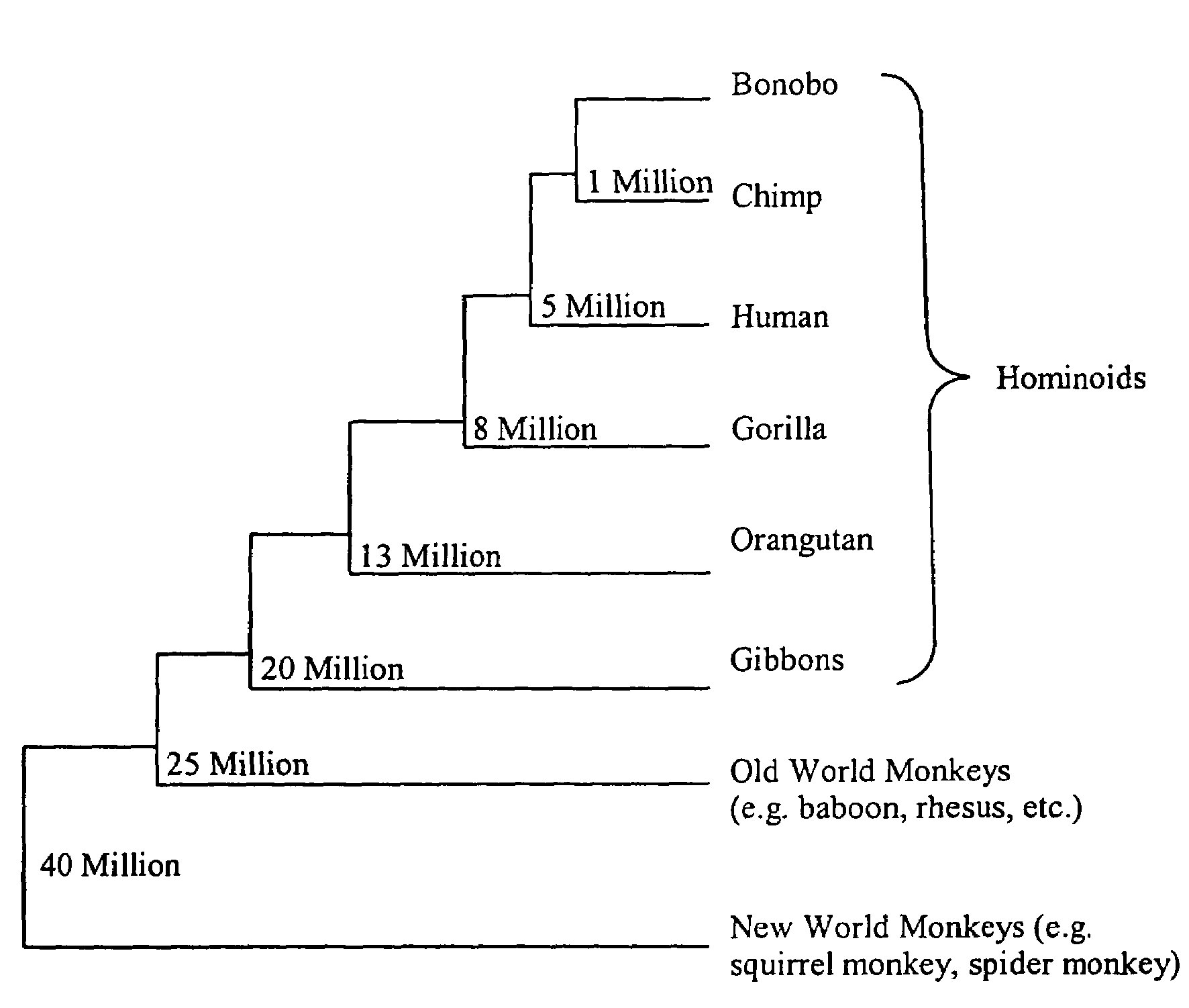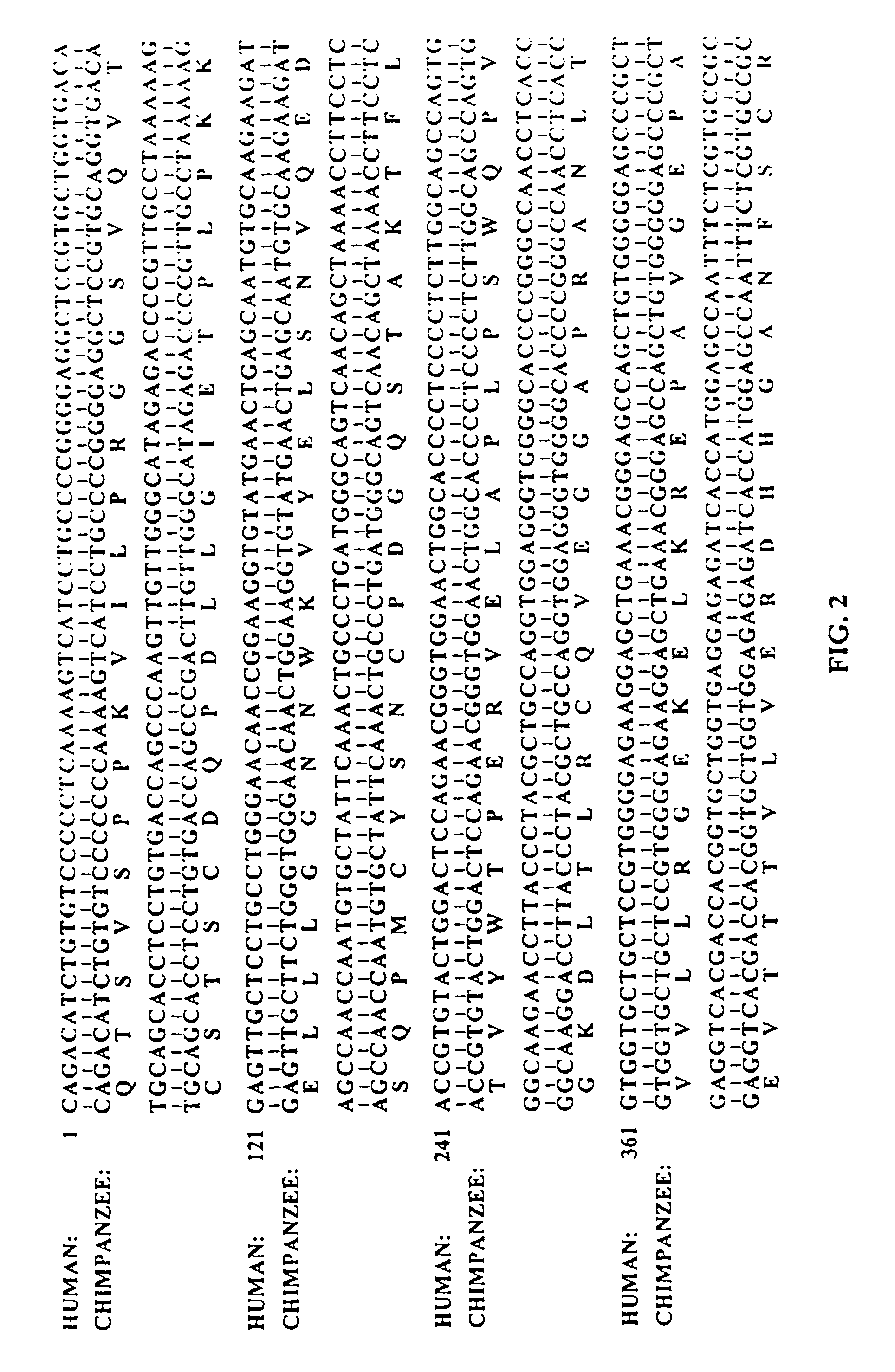Methods for identifying agents that increase the p44 function of microtubule assembly or resistance to HCV infection
a technology of microtubules and p44, which is applied in the field of methods for identifying agents that increase the p44 function of microtubules or resistance to hcv infection, can solve the problems of inability to resolve the nature of selective forces, limited application of methods in identifying genes, and new species, so as to reduce the resistance to the development of diseases, increase susceptibility, and reduce the resistance to the development
- Summary
- Abstract
- Description
- Claims
- Application Information
AI Technical Summary
Benefits of technology
Problems solved by technology
Method used
Image
Examples
example 1
cDNA Library Construction
[0202]A chimpanzee cDNA library is constructed using chimpanzee tissue. Total RNA is extracted from the tissue (RNeasy kit, Quiagen; RNAse-free Rapid Total RNA kit, 5 Prime-3 Prime, Inc.) and the integrity and purity of the RNA are determined according to conventional molecular cloning methods. Poly A+ RNA is isolated (Mini-Oligo(dT) Cellulose Spin Columns, 5 Prime-3 Prime, Inc.) and used as template for the reverse-transcription of cDNA with oligo (dT) as a primer. The synthesized cDNA is treated and modified for cloning using commercially available kits. Recombinants are then packaged and propagated in a host cell line. Portions of the packaging mixes are amplified and the remainder retained prior to amplification. The library can be normalized and the numbers of independent recombinants in the library is determined.
example 2
[0203]Suitable primers based on a candidate human gene are prepared and used for PCR amplification of chimpanzee cDNA either from a cDNA library or from cDNA prepared from mRNA. Selected chimpanzee cDNA clones from the cDNA library are sequenced using an automated sequencer, such as an ABI 377. Commonly used primers on the cloning vector such as the M13 Universal and Reverse primers are used to carry out the sequencing. For inserts that are not completely sequenced by end sequencing. dye-labeled terminators are used to fill in remaining gaps.
[0204]The detected sequence differences are initially checked for accuracy, for example by finding the points where there are differences between the chimpanzee and human sequences: checking the sequence fluorogram (chromatogram) to determine if the bases that appear unique to human correspond to strong, clear signals specific for the called base; checking the human hits to see if there is more than one human sequence that cor...
example 3
Molecular Evolution Analysis
[0205]The chimpanzee and human sequences under comparison are subjected to KA / KS analysis. In this analysis, publicly available computer programs, such as Li 93 and INA, are used to determine the number of non-synonymous changes per site (KA) divided by the number of synonymous changes per site (KS) for each sequence under study as described above. Full-length coding regions or partial segments of a coding region can be used. The higher the KA / KS ratio, the more likely that a sequence has undergone adaptive evolution. Statistical significance of KA / KS values is determined using established statistic methods and available programs such as the t-test.
[0206]To further lend support to the significance of a high KA / KS ratio, the sequence under study can be compared in multiple chimpanzee individuals and in other non-human primates, e.g., gorilla, orangutan, bonobo. These comparisons allow further discrimination as to whether the adaptive evolutionary changes a...
PUM
| Property | Measurement | Unit |
|---|---|---|
| volume | aaaaa | aaaaa |
| volume | aaaaa | aaaaa |
| resistance | aaaaa | aaaaa |
Abstract
Description
Claims
Application Information
 Login to View More
Login to View More - R&D
- Intellectual Property
- Life Sciences
- Materials
- Tech Scout
- Unparalleled Data Quality
- Higher Quality Content
- 60% Fewer Hallucinations
Browse by: Latest US Patents, China's latest patents, Technical Efficacy Thesaurus, Application Domain, Technology Topic, Popular Technical Reports.
© 2025 PatSnap. All rights reserved.Legal|Privacy policy|Modern Slavery Act Transparency Statement|Sitemap|About US| Contact US: help@patsnap.com



